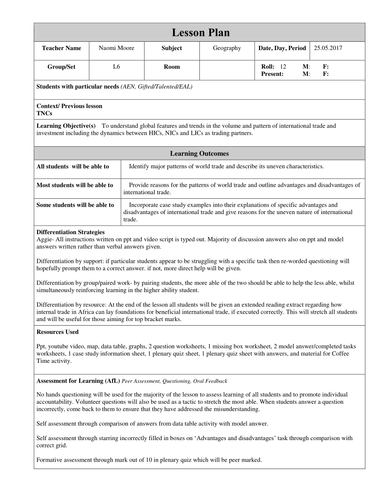














A Level lesson used successfully for interview lesson-later adapted into two lessons. Topic- volume, patterns and features of international trade. Relationships between trading partners particularly focused on the BRICS, the EU, the US, and sub-Saharan Africa.
Includes lesson plan, ppt, map and data table resources, instructions for creative trading task, question task worksheets and model answers, case study information sheets and missing grid worksheets,and plenary quiz and answers.
Starter- Video clip from Andrew Rugasira, an African CEO regarding trade and entrepreneurship in Africa.
-Activity 1- Coffee Time - practical activity where students are in groups and each given resources worth a certain price, or given capital and technology. The task is to buy/sell resources to manufacture or buy manufactured coffee. Students will have a worksheet to fill in before and after this activity where they will without realising it cover the main points of ‘terms of trade’
-Ppt slides and class questioning - Students will consider and be introduced to the reasons behind uneven trade using the exam technique tactic of SHEEP (Social, historical, environmental, economic and political). Students will then study Wallerstein’s World Systems Theory Model and apply groupings of countries to each section of the model.
Activity 2- Shifting trade winds- Students will work in pairs to analyse how the patterns of international trade have changed between 2002 and 2012. They will use a map and a data table to complete this activity. As a class we will then discuss reasons for these patterns and link these to globalisation. Students will be given a complete model answer.
Ppt slides and questioning- Students will be shown a line graph and a bar chart of FDI and be questioned on trends across developed and developing economies.
-Activity 3- Students will be introduced to the idea that there are advantages and disadvantages to international trade and they will be given a grid with key terms, definitions, case study example, and evaluation of whether it is an advantage or disadvantage. The grid has many missing boxes which students must individually fill in using a case study information sheet and a list of descriptions/key terms. Students will then be given a completed, correct version of the grid and they can star the areas where they were incorrect.
Plenary- 10 q quiz on all details of the lesson including quiz with answers
Something went wrong, please try again later.
So much included, could probably stretch to three double lessons and I downloaded everything without a problem. Truly excellent resource.
I couldn't open this resource... so I've been conned out of my money!
Report this resourceto let us know if it violates our terms and conditions.
Our customer service team will review your report and will be in touch.